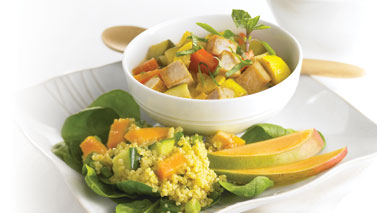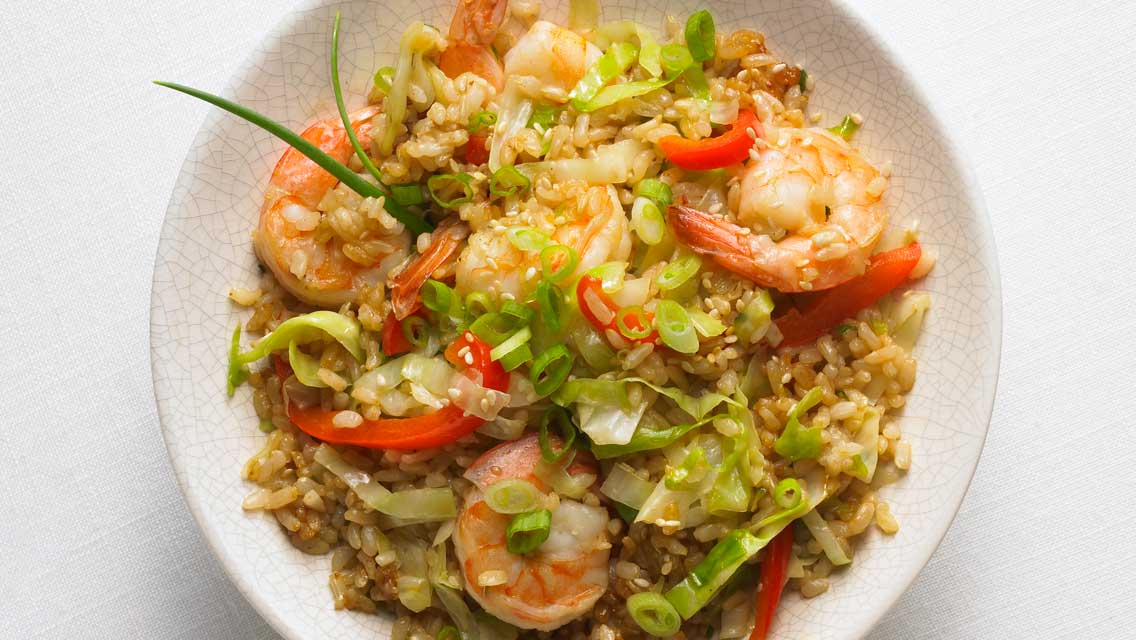If there’s anything I hate, it’s the whipsaw lunacy of day-to-day food trends. Now it’s pomegranate! Now it’s açaí! Did you hear that Oprah’s eating almonds? To the almond orchards, storm the trees!
Wait, come back.
Now it’s kale. Kale smoothies. Kale cobbler. This week kale has been sewn into a sweet Boho-chic dress to complement any occasion!
Of course, there’s nothing wrong with kale — or açaí or almonds or pomegranates. They’re all fantastic. It’s just that they were fantastic the day before the trend broke, and they’ll be fantastic long after we all take our recently purchased flaxseed grinders to the nearest Goodwill.
I suppose one of the reasons we get so enamored with the seemingly latest and greatest food fads is that deep down, most of us, and most of our reporter friends writing about health, know that the truth just isn’t that exciting. In fact, it’s as mundane as it is simple.
The headline? Cook at home, and eat more . . . well, everything.
Everything that’s not made up of meat, sugar, or starch, that is: more green beans, garlic, bell peppers, eggplants, tomatoes, collard greens, squash, zucchini, green peas, broccoli, chard, kale, and lentils; more asparagus, runner beans, chickpeas, parsley, olives, buckwheat, salmon, shad roe, clams, oysters, mussels, and miso; more cranberries, blueberries, and blackberries; more flaxseeds, sunflower seeds, and pumpkin seeds.
I could do this all day. You could do this all day. It’s not rocket science. But good habits are hard to start, and it’s even harder to fight the hype about miracle diets, wonder drugs, and quick fixes. After all, we’re busy, hungry people.
In his book In Defense of Food, author Michael Pollan instructed his readers to “Eat food. Not too much. Mostly plants.”
Personally, I don’t think you even need to bother with the “not too much” part. After all, nutritional starvation is one of the great, unexplored features of the American diet. More and more of us start life drowning in diet sodas, microwavable dinners, and Lunchables, and then we enter adulthood thinking we can do battle armed with Red Bull, vodka, frozen pizza, and fast-food burgers. It’s no wonder we’re getting sick. And it’s no wonder we’re not taking the steps necessary to fix the problem. I mean, at this point, what the heck are our brains really made of?
Speaking of brains: What did George Washington, Socrates, Genghis Khan, Gandhi, St. Francis of Assisi, Lead Belly, Hokusai, and Jane Austen have in common? They all lived on diets we now recognize as organic, hormone-, pesticide-, herbicide-, and antibiotic-free. Why? Well, I think it might simply be that they didn’t know any better.
The existence of vitamins D, B1, and K was not discovered until the 1920s. Whether antioxidants could prevent disease began to be seriously studied in the 1990s. Now, bioactive compounds in plants such as glucosinolates and isoprenoids are being touted as possible cancer fighters and heart-disease preventers.
What are glucosinolates and isoprenoids, you ask? That’s the stuff in broccoli — really good stuff. If you’re deficient in glucosinolates, in fact, it might help explain why you’re sometimes so freaking hungry you could bust through the vending-machine glass and eat all the Bugles.
What else is in broccoli? Stay tuned for another 20 years and you’ll find out. There are literally hundreds of components in that simple green vegetable, each of which reacts with other components in your body and in your food (fat-soluble compounds, for instance, need some fat to be absorbed). And we only really know about broccoli because people are studying it. Are there hundreds of chemical compounds in collard greens, upland cress, and pea shoots? No doubt. What about carrots, rhubarb, and pomegranates? Well, I’ll get to those studies when I get to them. Until then, the best we can do is . . . eat more plants.
Even when you’re not eating plants, eat and drink stuff made of plants.
Wine aged in oak is such a concentration of plants, for instance, that I think of it as European folk medicine. To make a traditional oaked red wine, you hustle up a whole bunch of wine grapes. These are usually smaller than table grapes and have a higher ratio of skin to juice, which means you get a lot of plant extract when you smash them down.
So you take your grape cluster, you smash the whole thing down, and let the seeds, stems, skins, and juice stew around together, so that plant components leach out of the stems and seeds. Then, wild yeast, another plant, comes in and turns the sugar in this grapey brew into alcohol. The alcohol extracts more components. And some of the yeast dies and becomes part of the brew — more plant matter.
So the next time you’re deciding between that merlot and a rum-and-Coke, don’t forget about the plants. Come to think of it, do that all the time. Red Bull or coffee? Choose coffee. It’s made of plants. Diet drink powder or tea? Tea! Made of plants.
Now, I know what some of you are thinking (snide smiles on your faces). What do I do when forced to choose between a bag of potato chips and a bag of organic carrots? They’re both made out of plants, after all. Well, smarty pants, industrial processing can really take the plant-ness out of plants. So, unless you’re feeling argumentative or your brain is scrambled, I’m guessing you know a real plant when you see one.
Of course, a lot of food companies are in the business of scrambling your brain. I mean, is a deep-fried, shelf-stable bag of carrot chips the same as a carrot? No. But that can be hard to remember when you’re working late and that vending machine down the hall is beckoning.
Speaking of working late: Is that a sometime thing or an all-the-time thing? Are you working late because you’re fried and out of ideas, exhausted and working inefficiently, or being bossed around by a jerk? Sure, sometimes we all have to work late. If you don’t eat a healthy dinner for a decade, however, you’re in big trouble.
You need to spend time taking care of yourself, and that starts with feeding yourself properly. That’s easy to say, I know. But it’s worth every second. Think about it: What could be more valuable and productive than standing in your kitchen, peeling carrots? It gives your brain a little downtime to work over other tasks; the food you’re preparing will help your body (and that brain) thrive; and showing your kids how to peel a carrot sets them up for a better life. Come to think of it, the benefits of peeling a carrot — or a cucumber, or trimming the leaves off a strawberry — are all but infinite.
So why don’t we have time to peel carrots in the kitchen? I know, I know — because we’re busy, hungry people. And where is that getting us?
Tune in again in 20 years and I’ll let you know.




This Post Has 0 Comments